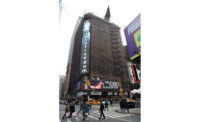New York City first launched its Facade Inspection & Safety Program in 1982 after a piece of falling terra-cotta killed a pedestrian in Brooklyn. Expansions and modifications to the program followed after other incidents with falling debris. Now the program, known as Local Law 11, may be getting another revamp. Rather than reacting to another incident, city officials are taking a proactive data-driven review of the regulations as they look for ways to remove construction sheds and scaffolding over sidewalks.
The city Dept. of Buildings recently selected multidisciplinary designer Thornton Tomasetti to conduct a review of the facade program. Under the existing program, owners of buildings taller than six stories are required to have an engineer or architect licensed as a qualified exterior wall inspector conduct an inspection and file a technical facade report with the agency every five years.
“Traditionally, [the facade program has] evolved as more of an organic rule in response to problems,” says Gary Mancini, managing principal of Thornton Tomasetti. “And so this is more of a scientific approach.”
When buildings are found to have unsafe conditions, owners must take action to prevent harm to the public, often by erecting a sidewalk shed until repairs can be completed. However, the rules have allowed some protective sheds to sit for years while repairs remain unfinished. Last year, Mayor Eric Adams and buildings department officials announced a “Get Sheds Down” initiative targeting what they said are longstanding “eyesores.”
Thornton Tomasetti and T2D2, an asset inspection software-as-a-service provider spun off by the firm, will use artificial intelligence to search through decades of inspection reports for patterns that may reveal conditions when facade failures are most likely, according to the buildings department. Financial terms of the contract have not yet been finalized, though the firm is starting the study while negotiations are wrapped up, says Andrew Rudansky, a department representative.
“This new scientific study will help us as we look to further refine these important regulations, so that they continue to keep New Yorkers safe, while ensuring that sidewalk sheds are only up when they are truly needed,” said Jimmy Oddo, buildings department commissioner, in a statement.
The aim is to refine the current one-size-fits-all approach to account for certain building materials or types of construction that may be less vulnerable to deterioration than others, Mancini says. That could involve reconsidering the extent or frequency of inspections, or adding additional categories to classify a facade’s condition—there are currently three categories: safe, unsafe and safe with a repair and maintenance program
At the same time, Mancini says thee aim is to avoid creating “something so refined that you need to have this complicated matrix to understand what to do on every building.”
The team plans to speak to other facade inspectors about their experiences and the problems faced, and to look at other facade ordinances of other cities, according to Mancini. The study will also look into how technology, such as drones and AI, can be used to create a larger and more accurate set of inspection data to allow designers to make better decisions.
The review is one piece of the Get Sheds Down effort. The buildings department has also stepped up enforcement, offered guidance on the use of safety netting instead of sidewalk sheds and hired two firms, Arup US and Practice for Architecture and Urbanism, both in New York City, to create six “better-looking, more cost-efficient designs,” among other actions.




